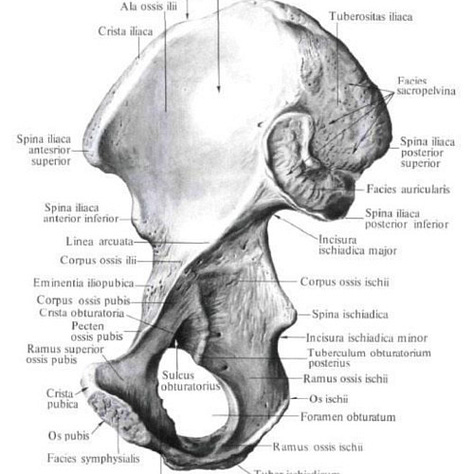ANATOMY: The sacred vessel of the pelvis
Discover the ossification of movement in the formation of the pelvic bones and how it manifests in our walking, plus locate a tiny anchorage for a new sense of stability.
Creating your own felt-sense of anatomical structures is the first step towards greater embodiment. Visualising, tracing and moving are the essential steps, however you can experience greater clarity and understanding when you let your imagination and curiosity become involved . Here are a few ideas to start your somatisation process.
1. TRACING THE CONTOURS
Find an anatomical picture of the bony pelvis and trace the bones with your fingertips. You could start by using one hand to trace the curve of the iliac crest while the other hand locates the "sit bone"; this can help you register the depth of the pelvis.
You might continue the tracing to find the meeting place of the two halves at the pubic symphysis and again place the other hand simultaneously on the sacrum to find a sense of the front back, and the location of the coccyx. Little by little you will have a more complete felt-sense of the shape and volume of the bowl of bone.
2. THREE IN ONE
Each pelvic half arises from the fusion of three separate ossification centres during gestation: the ilium, ischium, and pubis. In their coming together they create the small dish of the acetabulum that will contain the head of the femur.
Register the three 'separate' bony elements and the seams of their fusion. And maybe imagine the hip like a pestle and mortar, (not the pressing and grinding action though!) and allow the femur head to glide around all the inner surfaces of the dish.
3. LEMNISCATES
The meeting of the three elements are caught in the motion of a lemniscate, the lower part of which turns inward to meet at the pubic symphysis at the front.
This motion transforms the structure from two dimensions to three and provides a template for each half to rock, roll and rotate in a walking action. Attend closely to your gait, let your muscles be soft and the organs buoyant to cultivate a fluid current through multiple planes.



4. THE SACRED BONE
It is a long and winding rabbit hole I entered when looking for the reasons why the sacrum has this name. I have traveled beyond the Romans and the Greeks to pre-classical Mesoamerica and then into Ayurvedic terminology where I paused my journey and found the word "trika" suggesting a threefoldness, or the geometric resonance of the triangle (see various yantra) and this of course describes the wedge shape of the sacrum bone that inserts in the back to complete the bowl.
Honestly, there is so much to unpack here, so look out for companion articles where I will consider the bowl of the pelvis as the container of our organs of creativity, the sacrum as a shamanic portal, and ideas suggested by the naming of the sacral cakra - svādhiṣṭhāna: the dwelling place of the self.
5. CENTERING
A collection of muscles form an inner lining for the bony container and at the very mid-point of them is a structure called the perineal body. It is the meeting point, or anchor point, of the superficial and deep layers of the muscles of the perineum and contributes to the overall balance of biomechanical forces moving through the pelvis. When all four quadrants of the pelvis are in harmony then the perineal body is perfectly poised.
Try imagining a small bead in the centre of your bowl suspended by threads in all directions , or the circle at the centre of a dreamcatcher. Hold this image not only when you are sitting or standing still, but also in motion.
And as a final exploration, align the perineal body with your pituitary gland for a fine axis of connection.
Did you find this interesting? Useful? Want to explore further? Then please consider a paid subscription for a DEEP DIVE into my FIELD NOTES for extended movement enquiries, access to image collections, playlists, and journaling prompts.
I’m hugely grateful for each investment in supporting my time, thought and work. And, please do share this post to friends and colleagues. THANK YOU.





